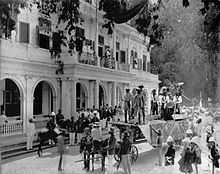
Back Quadre viu Catalan Živý obraz Czech Tableau (opstilling) Danish Tableau vivant German Vivanta bildo Esperanto Tableau vivant Spanish Tummpilt Estonian Tableau vivant Finnish Tableau vivant French Tablo ID


A tableau vivant (French: [tablo vivɑ̃]; often shortened to tableau; plural: tableaux vivants), French for 'living picture', is a static scene containing one or more actors or models. They are stationary and silent, usually in costume, carefully posed, with props and/or scenery, and may be theatrically lit. It thus combines aspects of theatre and the visual arts.
They were a popular medieval form which revived considerably from the 19th century, probably as they were very suitable for recording by photography. The participants were now mostly amateurs, participating in a quick and easy form of amateur dramatics that could be brought together in an evening, and required little skill in acting or speaking. They were also popular for various sorts of community events and parades.
In the late 19th and early 20th centuries, there was also a type of tableau used in the professional theatre, taking advantage of the extra latitude the law[citation needed] allowed for the display of nudity so long as the actors did not move. Tableaux featured poses plastiques ('flexible poses') by virtually nude models, providing a form of erotic entertainment, both on stage and in print. Tableaux continue to the present day in the form of living statues, street performers who busk by posing in costume. In film or live theatre the performers sometimes briefly freeze in position for a tableau vivant effect.
© MMXXIII Rich X Search. We shall prevail. All rights reserved. Rich X Search